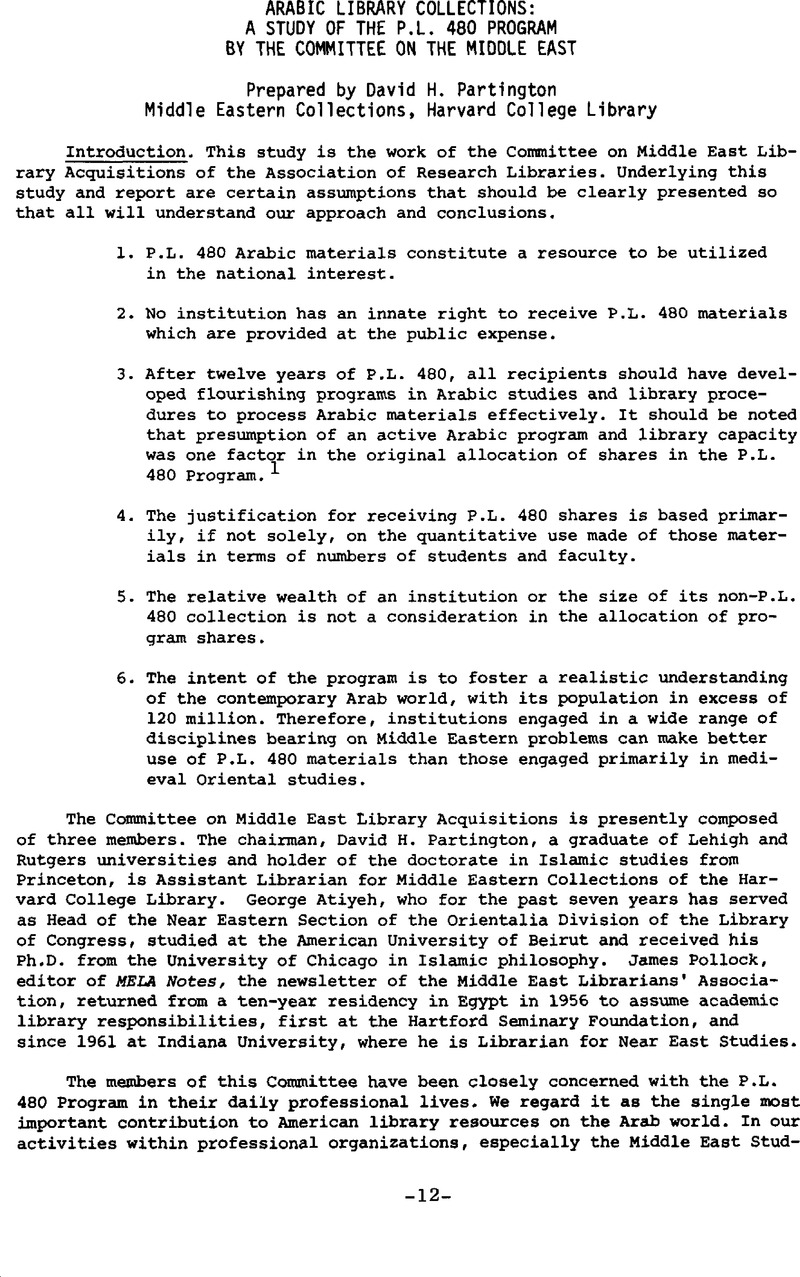Article contents
Arabic Library Collections: A Study of The P.L. 480 Program by The Committee on The Middle East
Published online by Cambridge University Press: 09 March 2016
Abstract

Information
- Type
- Other
- Information
- Copyright
- Copyright © Middle East Studies Association of North America 1975
References
Footnotes
1) One factor in the original allocation of shares was the presumption of an active Arabic program and library capacity.
2) The Library of Congress was not queried; nor were those libraries that have dropped out of the program, Syracuse and Arizona State, and Brandeis. The New York Public Library was polled, and also the Hartford Seminary which originally shared a set with what was Portland State College. The Hartford Seminary now receives only selected publications.
3) None was sent to the New York Public Library, nor to Boston College, which has no program of Arabic instruction.
4) See, for example, the critique set forth by Professor Richard Lambert in an address given to the Association of College and Research Libraries in Detroit, June 30, 1970: “Area studies and the library: a plea for data.” This important address, of which a typewritten copy was available to the author of this report, is apparently unpublished.
5) The first large-scale attempt to assess Arabic collections in this country was carried out by Mohamed El-Hadi in his Arabic library resources in the United States; an investigation of their evolution, status and technical problems. Univ. of Illinois, Ph.D. 1964 (University Microfilms : 65–808).
6) According to the Library of Congress, 13,947 monograph titles and 16,949 vols, were shipped from Cairo from 1963 through 1973. A 25 per cent reduction to allow for selection, discards, lost shipments, and books in languages other than Arabic, resulting in approximately 12,000 vols., will give a sound figure on which to calculate the increment in libraries due to PL-480.
7) Richard Lambert in his Language and area studies review, Philadelphia, 1973 (American Academy of Political and Social Science, Monograph no. 17), p. 38, finds 19 non-academic Middle East specialists working as librarians.
8) This report would not be complete without reference to the Arabic language program at Southwestern at Memphis College, and I thank Professor Darlene May for responding to the standard questionnaire. Southwestern has an enrollment of 22 students in a six-semester sequence of courses, plus “journalistic Arabic”. Two regular faculty members and one teaching fellow are competent in Arabic. In addition to the language courses, Southwestern regularly offers four different courses covering Islam and the Arab world, which attract some 75–90 students per year. To Southwestern, then, belongs the distinction of developing the most active program of Arabic studies in the Southeast. It was excluded from consideration in this study because it lacks the capacity for the university-wide range of research interests that are represented in the PL-480 materials.
9) It is interesting to compare here the figures for students of Arabic presented in Professor Lambert’s Language and area studies review, p.151. Lambert found an enrollment of 1,333 in 1970; our figures are: PL-480 schools, 888; non-PL-480 in this study, 395; Southwestern at Memphis,22 — making a total of 1305.
Professor Frederic J. Cadora, the Executive Secretary of the American Association of Teachers of Arabic, reports in correspondence that the number of students enrolled in Arabic is 2375. Cadora obtained this figure, which he calls conservative, from his Association’s records and from an examination of the 1972 MLA survey.
- 2
- Cited by

